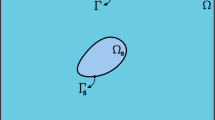Abstract
An immersed-boundary method is proposed for the analysis of conjugate problems of convective heat transfer in conducting solids. Inside the solid body, momentum forcing is applied to set the velocity to zero. A thermal conductivity ratio and a heat capacity ratio, between the solid body and the fluid, are introduced so that the energy equation is reduced to the heat diffusion equation. At the solid fluid interface, an effective conductivity is introduced to satisfy the heat flux continuity. The effective thermal conductivity is obtained by considering the heat balance at the interface or by using a harmonic mean formulation. The method is first validated against the analytic solution to the heat transfer problem in a fully developed laminar channel flow with conducting solid walls. Then it is applied to a laminar channel flow with a heated, block-shaped obstacle to show its validity for geometry with sharp edges. Finally the validation for a curvilinear solid body is accomplished with a laminar flow through arrayed cylinders.
Similar content being viewed by others
References
K. Fukagata, K. Iwamoto and N. Kasagi, Contribution of Reynolds stress distribution to the skin friction in wallbounded flows, Phys. Fluids, 14 (2002) L73–L76.
B. W. Webb and S. Ramadhyani, Conjugate heat transfer in a channel with staggered ribs, Int. J. Heat Mass Transf., 28 (1985) 1679–1687.
T. J. Young and K. Vafai, Convective cooling of a heated obstacle in a channel, Int. J. Heat Mass Transf., 41 (1998) 3131–3148.
C. W. Leung, S. Chen and T. L. Chan, Numerical simulation of laminar forced convection in an air-cooled horizontal printed circuit board assembly, Numerical Heat Transf. Part A, 37 (2000) 373–393.
J. M. House, C. Beckermann and T. F. Smith, Effect of a centered conducting body on natural convection -convective heat transfer -in an enclosure, Numerical Heat Transf. Part A, 18 (1990) 213–225.
M. Wang and J. G. Georgiadis, Conjugate forced convection in crossflow over a cylinder array with volumetric heating, Int. J. Heat Mass Transf., 39 (1996) 1351–1361.
N. O. Moraga and C. H. Salinas, Numerical model for heat and fluid flow in food freezing, Numerical Heat Transf. Part A, 35 (1999) 495–517.
G. Iaccarino, A. Ooi, P. A. Durbin and M. Behnia, Conjugate heat transfer predictions in two dimensional ribbed passages, Int. J. Heat Fluid Flow, 23 (2002) 340–345.
J. Kim, D. Kim and H. Choi, An immersed boundary finite volume method for simulation of flow in complex geometries, J. Comput. Physics, 171 (2001) 132–150.
J. Kim and H. Choi, An immersed boundary finite volume method for simulation of heat transfer in complex geometries, KSME Int. J., 18 (2004) 1026–1035.
S. Kang, G. Iaccarino and F. Ham, DNS of buoyancydominated turbulent flows on a bluff body using the immersed boundary method, J. Comput. Physics, 228 (2009) 3189–3208.
W. M. Kays and M. E. Crawford, Convective heat and mass transfer, 3rd ed., McGraw Hill, 108-158.
Author information
Authors and Affiliations
Corresponding author
Additional information
Recommended by Associate Editor Jungil Lee
Joon Ahn received his B.S. (1997), M.S. (1999) and Ph.D. (2003) degrees from Seoul National University, Korea. He worked as a Senior Researcher at KIER (2006−2010) and is now a Professor at Kookmin University. His research interests include heat transfer and combustion problems in energy systems
Rights and permissions
About this article
Cite this article
Song, J.C., Ahn, J. & Lee, J.S. An immersed-boundary method for conjugate heat transfer analysis. J Mech Sci Technol 31, 2287–2294 (2017). https://doi.org/10.1007/s12206-017-0425-5
Received:
Revised:
Accepted:
Published:
Issue Date:
DOI: https://doi.org/10.1007/s12206-017-0425-5




